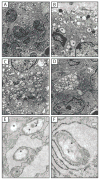Carney triad, SDH-deficient tumors, and Sdhb+/- mice share abnormal mitochondria
- PMID: 25808178
- PMCID: PMC4433412
- DOI: 10.1530/ERC-15-0069
Carney triad, SDH-deficient tumors, and Sdhb+/- mice share abnormal mitochondria
Abstract
Carney triad (CTr) describes the association of paragangliomas (PGL), pulmonary chondromas, and gastrointestinal (GI) stromal tumors (GISTs) with a variety of other lesions, including pheochromocytomas and adrenocortical tumors. The gene(s) that cause CTr remain(s) unknown. PGL and GISTs may be caused by loss-of-function mutations in succinate dehydrogenase (SDH) (a condition known as Carney-Stratakis syndrome (CSS)). Mitochondrial structure and function are abnormal in tissues that carry SDH defects, but they have not been studied in CTr. For the present study, we examined mitochondrial structure in human tumors and GI tissue (GIT) of mice with SDH deficiency. Tissues from 16 CTr tumors (n=12), those with isolated GIST (n=1), and those with CSS caused by SDHC (n=1) and SDHD (n=2) mutations were studied by electron microscopy (EM). Samples of GIT from mice with a heterozygous deletion in Sdhb (Sdhb(+) (/-), n=4) were also studied by EM. CTr patients presented with mostly epithelioid GISTs that were characterized by plump cells containing a centrally located, round nucleus and prominent nucleoli; these changes were almost identical to those seen in the GISTs of patients with SDH. In tumor cells from patients, regardless of diagnosis or tumor type, cytoplasm contained an increased number of mitochondria with a 'hypoxic' phenotype: mitochondria were devoid of cristae, exhibited structural abnormalities, and were of variable size. Occasionally, mitochondria were small and round; rarely, they were thin and elongated with tubular cristae. Many mitochondria exhibited amorphous fluffy material with membranous whorls or cystic structures. A similar mitochondrial hypoxic phenotype was seen in Sdhb(+) (/-) mice. We concluded that tissues from SDH-deficient tumors, those from mouse GIT, and those from CTr tumors shared identical abnormalities in mitochondrial structure and other features. Thus, the still-elusive CTr defect(s) is(are) likely to affect mitochondrial function, just like germline SDH-deficiency does.
Keywords: Carney triad; GIST; mitochondria; succinate dehydrogenase.
© 2015 Society for Endocrinology.
Conflict of interest statement
Figures




References
-
- Astuti D, Douglas F, Lennard TW, Aligianis IA, Woodward ER, Evans DG, Eng C, Latif F, Maher ER. Germline SDHD mutation in familial phaeochromocytoma. Lancet. 2001;357:1181–1182. - PubMed
-
- Baysal BE, Ferrell RE, Willett-Brozick JE, Lawrence EC, Myssiorek D, Bosch A, van der Mey A, Taschner PE, Rubinstein WS, Myers EN, Richard CW, 3rd, Cornelisse CJ, Devilee P, Devlin B. Mutations in SDHD, a mitochondrial complex II gene, in hereditary paraganglioma. Science. 2000;287:848–851. - PubMed
-
- Bulbul Dogusoy G. Gastrointestinal stromal tumors: A multicenter study of 1160 Turkish cases. Turk J Gastroenterol. 2012;23:203–211. - PubMed
-
- Carney JA. Gastric stromal sarcoma, pulmonary chondroma, and extra-adrenal paraganglioma (Carney Triad): natural history, adrenocortical component, and possible familial occurrence. Mayo Clin Proc. 1999;74:543–552. - PubMed
Publication types
MeSH terms
Substances
Supplementary concepts
Grants and funding
LinkOut - more resources
Full Text Sources
Medical

